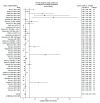Ambient Temperature and Cardiac Biomarkers: A Meta-Analysis
- PMID: 37539936
- PMCID: PMC10636793
- DOI: 10.2174/1573403X19666230804095744
Ambient Temperature and Cardiac Biomarkers: A Meta-Analysis
Abstract
This study quantified the effect of cold or heat exposure of ambient temperature on the alteration of well-known cardiac markers. A meta-analysis was performed using the PRISMA guidelines. Peer-reviewed studies on ambient temperature and cardiac biomarkers were retrieved from MEDLINE, ScienceDirect and Google Scholar from January 2000 to February 2022. The pooled effect sizes of ambient temperature on cardiac biomarkers c-reactive protein, soluble-cell adhesion-molecule-1, soluble-intercellular-adhesion-molecule-1, total cholesterol, low-densitylipoprotein, interleukin-6, B-type-Natriuretic-Peptide; systolic/diastolic blood pressure were quantified using a random-effects meta-analysis. A total of 26 articles were included in the metaanalysis after screening the titles, abstracts and full texts. The pooled results for a 1°C decrease of ambient temperature showed an increase of 0.31% (95% CI= 0.26 to 0.38) in cardiac biomarkers (p=0.00; I-squared=99.2%; Cochran's Q=5636.8). In contrast, the pooled results for a 1°C increase in ambient temperature showed an increase of 2.03% (95% CI= 1.08 to 3.82) in cardiac biomarkers (p=0.00; I-squared=95.7%; Cochran's Q=235.2). In the cardiovascular (CV) population, the percent increase in cardiac biomarkers levels due to a decrease/increase in ambient temperature was greater. This study showed the decrease/increase in ambient temperature has a direct correlation with the alterations in cardiac biomarkers. These findings are useful for managing temperatureassociated cardiovascular mortality.
Keywords: Meta-analysis; ambient temperature; blood pressure; c-reactive protein; cardiac markers; low-densitylipoprotein..
Copyright© Bentham Science Publishers; For any queries, please email at epub@benthamscience.net.
Conflict of interest statement
The authors declare no conflict of interest, financial or otherwise.
Figures





References
-
- Aronow W.S., Ahn C. Elderly nursing home patients with congestive heart failure after myocardial infarction living in new york city have a higher prevalence of mortality in cold weather and warm weather months. J. Gerontol. A Biol. Sci. Med. Sci. 2004;59(2):M146–M147. doi: 10.1093/gerona/59.2.M146. - DOI - PubMed
Publication types
MeSH terms
Substances
LinkOut - more resources
Full Text Sources
Research Materials

